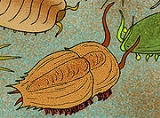
Nectaspida
Encyclopedia
The Nectaspida is an extinct order
of soft-bodied arthropod
s proposed by Raymond in 1920; its taxonomic status is uncertain. Specimens are known from the early Cambrian
to the upper Silurian
periods. Whittington (1985) placed the order in the Trilobita
. Cotton & Braddy (2000) place it in a new "Trilobite clade" containing the Trilobita, recognizing the close affinities of the Nectaspids to trilobites. However this necessitates the inclusion of genera that look very little like trilobites. Strictly speaking, it is best placed in the stem-group to the chelicerates.
to conform with the names of the other trilobite orders. Whittington described it in 1985 with the spelling Nektaspida; the revised 1997 Treatise by Raymond and Fortey uses this spelling, as do other modern works.
Order (biology)
In scientific classification used in biology, the order is# a taxonomic rank used in the classification of organisms. Other well-known ranks are life, domain, kingdom, phylum, class, family, genus, and species, with order fitting in between class and family...
of soft-bodied arthropod
Arthropod
An arthropod is an invertebrate animal having an exoskeleton , a segmented body, and jointed appendages. Arthropods are members of the phylum Arthropoda , and include the insects, arachnids, crustaceans, and others...
s proposed by Raymond in 1920; its taxonomic status is uncertain. Specimens are known from the early Cambrian
Cambrian
The Cambrian is the first geological period of the Paleozoic Era, lasting from Mya ; it is succeeded by the Ordovician. Its subdivisions, and indeed its base, are somewhat in flux. The period was established by Adam Sedgwick, who named it after Cambria, the Latin name for Wales, where Britain's...
to the upper Silurian
Silurian
The Silurian is a geologic period and system that extends from the end of the Ordovician Period, about 443.7 ± 1.5 Mya , to the beginning of the Devonian Period, about 416.0 ± 2.8 Mya . As with other geologic periods, the rock beds that define the period's start and end are well identified, but the...
periods. Whittington (1985) placed the order in the Trilobita
Trilobite
Trilobites are a well-known fossil group of extinct marine arthropods that form the class Trilobita. The first appearance of trilobites in the fossil record defines the base of the Atdabanian stage of the Early Cambrian period , and they flourished throughout the lower Paleozoic era before...
. Cotton & Braddy (2000) place it in a new "Trilobite clade" containing the Trilobita, recognizing the close affinities of the Nectaspids to trilobites. However this necessitates the inclusion of genera that look very little like trilobites. Strictly speaking, it is best placed in the stem-group to the chelicerates.
Naming history
The order was originally proposed by Raymond in 1920 as Nectaspia. Størmer corrected it to Nectaspida for the 1959 Treatise on Invertebrate PaleontologyTreatise on Invertebrate Paleontology
The Treatise on Invertebrate Paleontology published by the Geological Society of America and the University of Kansas Press, is a definitive multi-authored work of some 50 volumes, written by more than 300 paleontologists, and covering every phylum, class, order, family, and genus of fossil and...
to conform with the names of the other trilobite orders. Whittington described it in 1985 with the spelling Nektaspida; the revised 1997 Treatise by Raymond and Fortey uses this spelling, as do other modern works.
External links
- Are Naraoids trilobites? -- photographs of specimens and discussion of classification controversy.
- Order Nectaspida -- more technical overview with references and descriptions of known genera.

